June 9, 2006
Air Date: June 9, 2006
FULL SHOW
SEGMENTS
Price of Nation’s Newest Weather Satellites Soar – Its Future is Cloudy
/ Bruce GellermanView the page for this story
The nation’s ability to forecast weather is in jeopardy as existing satellites get older and the replacements are over-budget and under-performing. Living on Earth’s Bruce Gellerman reports. (12:00)
Storm Brewing
/ Jeff YoungView the page for this story
Hurricane forecasters agree we’re in for another busy storm season. But there's a debate about just why that is. The government's storm forecasters say it's mostly due to natural cycles in hurricane activity. A new study says it's really global warming at work. Living on Earth's Jeff Young reports. (05:00)
Stemming Red Tide
/ Ashley AhearnView the page for this story
Red tide hits the world’s coasts every year when toxic algae bloom offshore and are swept into coastal waters. But there’s a parasite that destroys red tide algae and could one day be used to fend off the toxic blooms. Living on Earth’s Ashley Ahearn reports. (05:00)
Cities in the Wilderness
View the page for this story
A conversation with Bruce Babbitt, former Secretary of the Interior, on the future of land use in the U.S. (06:00)
Emerging Science Note/"Doomsday" Seed Bank
/ Bobby BascombView the page for this story
Bobby Bascomb reports on Norway’s decision to put away some seed funds in the form of a two million species seed bank. (01:30)
Listener Letters
View the page for this story
Comments from our listeners. (02:30)
The Good Good Pig
/ Sy MontgomeryView the page for this story
Living on Earth’s commentator, Sy Montgomery’s famous pig, Christopher Hogwood, has passed on. But he left his owner with enough fond memories to write a book. And that’s just what she did. Sy Montgomery joins us to talk about her most recent book, The Good Good Pig. (10:30)
The Herons Return
/ Tom MontgomeryView the page for this story
Commentator Tom Montgomery-Fate writes about the return of the great blue heron to his farm in Michigan. (03:00)
This week's EarthEar selection
listen /
download
Customers looking for fresh fish get more than an earful at Seattle’s Pike Street Market.
Show Credits and Funders
Show Transcript
HOST: Steve Curwood
GUESTS: Bruce Babbitt, Sy Montgomery
REPORTERS: Bruce Gellerman, Jeff Young, Ashley Ahearn
NOTE: Bobby Bascomb
COMMENTARY: Tom Montgomery-Fate
[THEME MUSIC]
CURWOOD: From NPR, this is Living on Earth.
[THEME MUSIC]
CURWOOD: I’m Steve Curwood. Alberto, Beryl, Chris, Debby, and Ernesto. These are some of the names the National Weather Service has for this season’s tropical storms. Whether they will hit the U.S. coast is an unknown right now. But there is already a tempest in Congress about the notion that global warming is turning more and more of these storms into powerful hurricanes.
EMANUEL: There’s a really quite astounding correlation between the frequency of hurricanes in the Atlantic and the ocean temperature in the tropical Atlantic. The frequency, intensity and duration of the events are all going up with the ocean temperature.
MAYFIELD: I know there are those who believe that even if the global warming actually impacts the intensity of the storms, its impact is relatively small compared to the decadal signal.
CURWOOD: The debate over ‘canes and climate on Capitol Hill this week on Living on Earth. Stick around.
[NPR NEWSCAST: [MUSIC – Boards of Canada “Zoetrope” from ‘In a Beautiful Place Out in the Country’ (Warp Records – 2000)]
ANNOUNCER: Support for Living on Earth comes from the National Science Foundation and Stonyfield Farm.
[THEME MUSIC]
Price of Nation’s Newest Weather Satellites Soar – Its Future is Cloudy
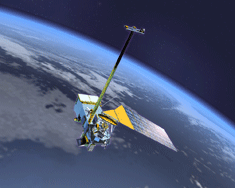
Artist’s rendition of NPOESS – the next generation of weather satellites. (Photo courtesy of: NOAA)
CURWOOD: From the Jennifer and Ted Stanley Studios in Somerville, Massachusetts, this is Living on Earth. I’m Steve Curwood.
[TV Satellite weather…fade]
CURWOOD: The first weather satellites were launched forty years ago. Today the images they send back from space of earth’s weather are a routine part of life.
[TV Satellite weather…fade]
CURWOOD: Thanks to these sophisticated satellites loaded with high tech sensors, it’s now possible to predict the weather with great accuracy. But a program to build the nation’s next generation of weather satellites is years behind schedule and billions of dollars over budget. And as Living On Earth’s Bruce Gellerman reports, the crisis could jeopardize our ability to forecast the weather.
GELLERMAN: It started with re-inventing government. In 1994, Bill Clinton signed a presidential directive designed to change the way the United States purchased weather satellites. Until then NASA, the Air Force, and NOAA, the National Atmospheric and Oceanic Administration, each designed, purchased and ran its own weather satellite program. Clinton’s directive merged the three into one and, to manage it, they created a special position at NOAA. And in an unusual move, the government offered the builders of the satellites and their senior executives generous incentives to keep the project on budget and on schedule.
Amy Butler, military editor at Aviation Week and Space Technology, says the Clinton administration predicted the new way of buying satellites would save taxpayers nearly two billion dollars.
BUTLER: There was this faster, better, cheaper idea out there. The government basically said we don’t have as much money to spend but we still want to have the highest technology and the best spacecraft, so industry, come back to us and tell us what you can conjure up in your crystal ball.

Artist’s rendition of NPOESS – the next generation of weather satellites. (Photo courtesy of: NOAA)
[ANIMATION: "NPOESS…next century…"]
GELLERMAN: NPOESS was designed to replace the nation’s aging military and civilian weather satellites with a new generation of eyes in the sky: six satellites bristling with some of the most advanced weather measuring instruments ever developed for space.
[ANIMATION: the instruments….to our future…]
GELLERMAN: NPOESS state-of-the-art sensors would make five-day weather forecasts as accurate as our current three-day predictions. In fact, with NPOESS, meteorologists could make not just forecasts but “nowcasts.” The satellite’s high-speed communication links would give scientists on the ground almost instant access to data gathered in space.
The defense department also had high hopes for NPOESS. It meant that instead of just coping with the weather, military planners could anticipate and exploit it for tactical advantage. Critical to this mission was an advanced sensor called VIIRS, an infrared device designed to peer through clouds day and night, scanning the earth and oceans. As this promotional video explains, VIIRS promised to make it possible to more accurately predict when and where hurricanes hit.
[VIIRS….Audio]
GELLERMAN: But it turns out building weather satellites and sensors is rocket science.
[VIIRS …Audio]
GELLERMAN: While Northrop Grumman is the prime contractor of NPOESS, Raytheon is the subcontractor responsible for building the billion-dollar VIIRS sensor. Raytheon engineers had experience building a similar instrument and expected few problems with VIIRS. But by 2004 it became obvious the company had vastly underestimated the task. The sensor was too heavy. Its cooling system failed. There was electronic interference. The staff was fired and replaced.
The government project manager began calling VIIRS ‘our problem child.’ By mid-2005, Congress took notice. That's when lawmakers were notified that delays in the VIIRS sensor were stalling the entire weather satellite program. But the real surprise came when members of the House Science Committee were briefed last fall. Republican Chairman Sherwood Boehlert says lawmakers got a heavy dose of satellite sticker shock.
BOEHLERT: There are a lot of reasons to be shocked at this stage of the proceedings. That is shocking to me in my official capacity. It is shocking to me as a taxpayer.
GELLERMAN: NPOESS was supposed to cost six and a half billion dollars, but by last summer the price tag had risen to eight billion dollars. By December it soared. The Department of Defense estimated it would cost nearly fourteen billion dollars. Congressman Boehlert says that’s more than three times the annual budget of NOAA, the agency that’s in charge of the weather satellite program.
BOEHLERT: But the fact of the matter is there were all sorts of warning signs along the way that things were getting somewhat out of control, and finally it spun almost completely out of control.
GELLERMAN: Both Northrop Grumman and Raytheon refused repeated requests for on-the-record interviews about their satellite contracts. Northrop Grumman did initiate a series of so-called ‘Deep Dive’ investigations of the program and its subcontractors, yet, inexplicably, at the same time it was giving Raytheon an award for being on budget and on time.
Congress also investigated, and so did NOAA's Inspector General Johnnie Frazier. Frazier focused on the money trail. He discovered that while the government's project manager, John Cunningham, was well aware of the growing problems, he continued to pay Grumman $124 million dollars in incentive awards. That's nearly all of what Grumman would have earned had it actually been on budget and on schedule. Frazier testified before Congress in May:
FRAZIER: That fee is intended to produce excellence, it’s intended to encourage performance. If I give you 84 percent of the fee when you have a horrible track record, what incentive do you have to try to do better? I think almost none.
GELLERMAN: Federal investigators also discovered that senior government officials who bore ultimate responsibility for NPOESS had met only twice in one and a half years while the program was careening out of control. One of those senior officials in charge was NOAA Administrator Admiral Conrad Lautenbacher. Lautenbacher refused to meet with the Inspector General, Johnnie Frazier, but he did testify before Congress.
LAUTENBACHER: I have agreed that we’ve learned the lessons that Johnny has talked about. This is a difficult program to manage, because it has three agencies and it has complexities involved technically, which are very challenging. Remember I’m the head of an agency, so I’ve got lots of people and lots of problems and lots of programs that all need help. This is a top priority and I spend a lot of time on this one, but there’s only so much that I can absorb and understand.
GELLERMAN: Neither Republicans nor Democrats were buying his explanation. Heads began to roll. The NPOESS program director was fired, Raytheon and Grumman replaced senior officials, so did the Air Force. And after hearing Lautenbacher's testimony, ranking Democrat Bart Gordon was almost speechless, but he made it clear he wanted the admiral to go, too.
GORDON: You know, you’re an admiral. You know, I mean, that is, you know, I mean, in sum, this is just embarrassing. I just simply can’t understand it. I would be embarrassed to be in your situation and not try to do more. And not to even meet, to get more information, it just gives me great concern.
GELLERMAN: Now when military contracts rise more than 25 percent over their original bids it triggers a mandatory review by the Department of Defense. If military officials found the weather satellite system wasn't necessary for national security, they could kill it. Congressman Sherwood Boehlert quoted Woody Allen to characterize the situation.
BOEHLERT: We’ve arrived at the crossroads. One road leads to hopelessness and despair, the other to total extinction. Let us pray we have the wisdom to choose wisely.
GELLERMAN: After an intense review, the Pentagon chose to keep NPOESS alive. Military officials concluded the weather satellite program was essential to national security. But it cut the program dramatically. The first launch date has been pushed back five years to 2013, and now the government plans to buy not six satellites, but just four. And the price tag? It's almost double the original estimate.
In addition, five instruments that had been planned will be eliminated, including those that were to help track climate change. However, VIIRS, the infrared sensor that was responsible for most of the cost overruns and delays, was not cut. It will be built. But reporter Amy Butler of Aviation Week and Space Technology doubts that, even with these changes, this is the end of the weather satellite's problems.
BUTLER: I've seen the government say many times, this is final, we know what we're doing, we know the root cause of the problem and we know how to fix it. And a year or two later, they're kind of back up on the Hill, their head held low, their tail tucked under, and they say, well, we got another billion dollar problem, could you help us out on that?
GELLERMAN: This is a high-stakes game. The nation's current generation of weather satellites is getting old. Further delays in the satellite program could cause gaps in the ability to forecast the weather as early as next year. The government plans to patch those gaps with data from existing military satellites and European orbiters – this at a time when world weather patterns are becoming less predictable. For Living on Earth, I'm Bruce Gellerman.
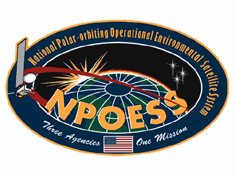
National Polar-orbiting Operational Environmental Satellite System (NPOESS) (Photo courtesy of: NOAA)
GELLERMAN: That’s precisely right, but you know Steve, it’s not just our weather satellites system that’s in serious trouble, but our entire constellation of orbiters: the spysats, communication, navigation, you name it. They’re mostly from the Cold War era, and the government is now in the process of replacing them all, but all of them, Steve, all of them have a problem. I recently spoke with defense consultant Loren Thompson from the Lexington Institute.
THOMPSON: One thing that they all have in common is that they’re over budget and they’re behind schedule. When you see a pattern like that regardless of who the contractor is, the conclusion you come to is that this must be an endemic problem with the customer, in other words, with the government.
CURWOOD: Okay Bruce, so it’s the government’s fault, maybe government’s just too tough a customer?
GELLERMAN: Well, yeah, but except for Bowing, for these satellite builders - and there are only a few of them – the government is their only customer.
CURWOOD: So you’re saying there’s no competition, and that’s the problem?
GELLERMAN: No there is competition, it’s tremendous and intense between contractors like Northrop and Raytheon, but I spoke with Jeremy Singer – he’s a reporter with Space News – and he’s investigated this issue, and he says it’s precisely the intense competition that contributes to the problem.
SINGER: You know, one of the other problems has just been very poor cost estimating with satellites, in part driven by the budget constraints that the Pentagon has, and contractors who are effectively incentivized to underbid on the programs, and they would come in with cost estimates that they knew they couldn’t meet. Ultimately the budgets would balloon.
CURWOOD: So what you’re saying is that in other words the government expects too much from the satellites it buys, it’s willing to pay too little, so therefore the defense contractors figure this out, and to win the bids they low ball their estimates but then they come back looking for a lot more.
GELLERMAN: Precisely, and that’s why we’ve got very serious problems with virtually every satellite we’ve got in the sky.
CURWOOD: Living On Earth’s Bruce Gellerman. Thanks Bruce.
GELLERMAN: You’re very welcome.
Related links:
- NPOESS – National Polar-Orbiting Operational Environmental Satellite System
- Northrop Grumman Corporation
- U.S. Government Accountability Office Report
- Inspector General's investigation:
[MUSIC - Radiohead “Packt Like Sardines In A Crushd Tin Box” from ‘Amnesiac’ (Capitol - 2001)]
Storm Brewing
CURWOOD: Coming up: a lot of stormy weather, hurricane style, is predicted by many experts this year. But they can’t agree on why. Stay tuned to Living on Earth.
[MUSIC: Brian Eno “Fractal Zoom” from ‘Compounds + Elements’ (All Saints Records – 2006)]
CURWOOD: It’s Living on Earth, I’m Steve Curwood. Hurricane forecasters say we’re in for yet another busy storm season in the Atlantic. The government’s hurricane center expects between eight and ten hurricanes this year, with as many as six of them becoming major storms.
And along with these predictions come new scientific studies linking the intensity of hurricane activity to global warming. It’s a topic of fierce debate among hurricane scientists, and it’s a debate with major implications for public policy. Living on Earth’s Jeff Young reports on the emerging science, and why Washington is now listening.
YOUNG: In these anxious, early days of hurricane season, hurricane scientists are in high demand on Capitol Hill. Academics and officials from NOAA – the National Oceanic and Atmospheric Administration – are busy briefing lawmakers on yet another stormy summer. NOAA Hurricane Center Director, Max Mayfield, blames a combination of warm water, weak trade winds and areas of low pressure – hurricane-making conditions he says come around every couple of decades.
MAYFIELD: Many believe these favorable conditions, which came together around 1995, are part of a multi-decadal climate pattern, which last peaked in the 50s and 60s and could last another 10 to 20 years.
YOUNG: Charts of Atlantic storm activity show lots of hurricanes in the 50s and 60s, then quiet in the 70s and 80s. Now we’re in the midst of another busy period. Mayfield calls it a multi-decadal signal and says it’s a natural cycle in hurricanes.
And what about studies linking global warming to hurricane strength? Mayfield’s boss, Louis Uccellini, says that’s an important area of research at NOAA’s National Centers for Environmental Prediction. But Uccellini says the most important factor in hurricane activity is that natural cycle Mayfield described.
UCCELLINI: So we’re looking at this decadal oscillation as a key driver for what we’re seeing today in terms of the hurricane numbers and intensity in the Atlantic.
YOUNG: But some emerging science questions that underlying assumption of a “natural” hurricane cycle. MIT professor Kerry Emanuel just published his latest paper arguing that a rise in sea surface temperature, due to global warming, is really what’s at play. Emanuel says he even surprised himself with the findings. Not long ago he agreed with the theory of natural storm cycles.
EMANUEL: But further work on this suggests that we – collectively, massively – fooled ourselves into thinking that there is something cyclic about Atlantic variability.
YOUNG: At yet another Capitol Hill briefing, Emanuel argued that the quiet period in the 70s was due to pollution and volcanic activity blocking some sunlight, effectively countering global warming for a while. He showed a chart tracking sea surface temperatures and storm activity in the Atlantic over the years. The two lines match far more closely than anyone expected.
EMANUEL: There’s a really quite astounding correlation between the frequency of hurricanes in the Atlantic and the ocean temperature in the tropical Atlantic. The frequency, intensity and duration of the events are all going up with ocean temperature.
YOUNG: Emanuel’s findings are controversial. Hurricane center forecaster Chris Landsea challenged Emanuel at the same Hill briefing. Landsea says there are just too many gaps in the data to draw such a conclusion.
LANDSEA: Our ability to monitor hurricanes means we’re sensing these big changes and how strong they are, more than we could in the past, and this has led to artificial increases in the databases. Hurricanes are showing up stronger, but I think it’s an artifact of the data.
YOUNG: Emanuel agrees the historical data have flaws, but not enough to change his conclusion. And the implications of his conclusion are worrisome.
EMANUEL: If we’re right, and I think we probably are in this case, there’s no reason to expect a downturn again. We’ll certainly have quiet years. But I don’t think we’ll see a quiet decade again for a long time.
YOUNG: Other recent studies link climate change and the power of hurricanes around the world. A Purdue University paper found the total power produced by tropical cyclones has roughly doubled over the last 40 years, due to an increase in sea surface temperature. That reinforced earlier findings by Georgia Tech professor Peter Webster. Webster found the number of hurricanes that reached Category 4 and 5 worldwide nearly doubled since 1970.
These papers quickly became part of the global warming debate in Washington. Environmental groups are eager to use hurricanes as potent symbols for the danger of global warming. And industry-funded think tanks are just as eager to cast doubt. Climate scientist Peter Webster found himself the target of some sharp personal attacks.
WEBSTER: The sad thing now is that the debate we’re having is less than pleasant. I’m not sure why that is. I find that personally very disturbing.
YOUNG: Uccellini, at NOAA, says it’s now more important than ever for scientists to clearly communicate their findings about climate change and hurricanes and the level of uncertainty in that work.
UCCELLINI: I think the issue sort of gets magnified as to what happens after the science is done and how does that get translated into policy. The stakes are high, and that’s why I think everybody inside and outside of government dealing with these issues in a professional way have to be very careful how they proceed.
YOUNG: The study of hurricanes could be in for some stormy weather itself. For Living on Earth, I’m Jeff Young in Washington.
Related links:
- NOAA hurricane predictions for 2006
- Purdue University study linking global warming with rising cyclone intensity
- Penn State press release on Emanuel/Mann study
- Georgia Tech press release on Webster study
- Emmanuel/Mann study
Stemming Red Tide
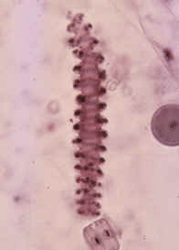
Vermiform stage of the Amoebophrya parasite after an emergence from the host. (Photo courtesy of: Smithsonian Environmental Research Center)
CURWOOD: If you’re fond of eating clams and oysters, you probably don’t like the paralytic shellfish poisoning that’s caused by Red Tide, a seasonal bloom of algae. Along the Eastern seaboard of the US, the Alexandrium Fundyense algae is the culprit, and can cost shell-fishermen millions in lost revenue. But it might not for long. Scientists at the Woods Hole Oceanographic Institute are developing possible solutions to kill off future red tides. Living on Earth’s Ashley Ahearn reports.
AHEARN: In warm, sunny summer waters off the East Coast, life is good for the Alexandrium Algae. The single celled organisms float near the surface, photosynthesizing and multiplying like there’s no tomorrow. But there’s one critter that can take all the fun out of being a free swimming Alexandrium.
SENGCO: I saw these little green bodies inside the red tide-causing organism Alexandrium, and on closer inspection it turned out to be this parasite that is found in Alexandrium.
AHEARN: Mario Sengco was a PhD student at the Woods Hole Oceanographic Institute when he came across Alexandrium algae’s worst nightmare, the Amoebophrya parasite.

Vermiform stage of the Amoebophrya parasite after an emergence from the host. (Photo courtesy of: Smithsonian Environmental Research Center)
AHEARN: The parasites take control of a healthy Alexandrium cell and drag it down into darker waters. Then, the parasites suck nutrients from their weakened host and get ready to make their exit in search of new prey.
SENGCO: In one corner of the host peeps out this thing. It’s this very long chain of cells that has little flagella on its side that’s swimming, pushing, trying to come out of it’s host, and then it breaks off from it’s host and starts to swim away, wiggle away. And what’s left is the empty husk or shell of the host.
AHEARN: When Mario Sengco realized that he’d found a natural predator of the poisonous red tide algae, he knew there was more to be learned about this little pest.
SENGCO: So our first big question is: what is the role of this parasite in the population dynamics of its host, Alexandrium?
[MOTOR BOAT SOUND]
AHEARN: That’s where Dave Kulis comes in. Kulis is a senior research assistant at the Woods Hole Oceanographic Institute, and today he’s collecting samples from three spots on Salt Pond. Salt Pond is a small, tidal pond on Cape Cod that serves as a microcosm of the Alexandrium algae’s life cycle in the open ocean.
[BOAT ENGINE IDLING DOWN “We’re good here”. ENGINE CUTTING OUT]
KULIS: This is an integrated sample. We’ve got this two-meter long PVC pipe and we can close it off on the top end and capture a two-meter column of water.
AHEARN: Kulis sticks the long PVC straw into the water to get a general measure of the amount of Alexandrium and parasites in the pond. At our next site, the sampling gets more specific.
[PUMP SOUNDS]
KULIS: So what we’re going to do here is we’re going to pump water at discrete depths from the bottom up to the surface.
AHEARN: The samples tell the scientists how both healthy and parasite-infected Alexandrium cells move around. This is how they found out that the infected Alexandrium cells sink before splitting open to release their parasitic invaders. But there’s a missing link in what scientists like Mario Sengco know about the lifecycle of the amoebophyra parasite.

Woods Hole researcher Mario Sengco (Photo: Tom Kleindinst)
AHEARN: When nutrients run out after the big snowmelts in the spring are flushed out to sea, Alexandrium algae cells stops dividing and instead start to form cysts, fertile little red tide time capsules, that sink to the bottom, and wait it out for fresh nutrients the following spring.
SENGCO: So we collected samples on the bottom of Salt Pond to look at the cysts being produced by the Alexandrium host and tried to see if we could find parasites within them.
AHEARN: When parasites infect Alexandrium in the pre-cyst phase, they stop the algae cells from dividing. So Sengco has a hunch that if the parasites get into the Alexandrium cysts, they’ll make them infertile as well, preventing further red tide blooms.
Even though Sengco may have discovered a natural birth control for red tide, he’s not advising dumping extra parasites into the ocean anytime soon. But he says that in learning more about red tide’s killer, we can learn more about red tide itself.
SENGCO: We focus a lot on how blooms begin, but there are not many studies that focus on how blooms end. We have to understand how these parasites can contribute to the decline of blooms, or how long a bloom persists in nature, from a biological perspective.
AHEARN: For Living on Earth, I’m Ashley Ahearn in Eastham, Massachusetts.
Related links:
- For more information on predictions for this year's red tide bloom go to:
- Click here to see clips of the parasite predator in action.
[MUSIC - Psapp “Calm Down” from ‘Tiger, My Friend’ (The Leaf Label – 2004)]
Cities in the Wilderness

Former Secretary of the Interior Bruce Babbitt (Photo: Michael Paulson)
CURWOOD: America, America. How does our nation grow? With strip malls and suburban subdivision walls, and four-lane highways all in a row. That question and answer cut straight to the issue of land use in America. And a new book by Bruce Babbitt tackles the subject.
As Secretary of the Interior in the Clinton Administration, Babbitt oversaw conservation issues from the restoration of the Everglades to the protection of endangered species habitat in California.
His book is called “Cities in the Wilderness: A New vision of Land Use in America.” Secretary Babbitt, welcome.
BABBITT: Steve, it’s a pleasure to be here.
CURWOOD: Now, Bruce Babbitt, you’re talking about land use policy, and these days it seems that the shibboleth is that local folks should decide what happens to the land. Why the need for a federal land use policy?
BABBITT: It’s really interesting, because, you know, we do think of land use in terms of building the next subdivision, the location of the church, school, supermarkets, primarily as a local matter. But you know the fact is we’ve always had a national land use policy, which says, not explicitly, that the federal government subsidizes every conceivable form of development. So the federal government, in a sense, is the causative force behind an awful lot of this sprawl.
And my contention in this book is we need to recognize we’ve always had a national land use policy – it’s called development. I’m not proposing that we abolish that, but I’m proposing that alongside that federal land use policy called development there should be an articulated policy to say we’re going to have good land use planning. I suppose the question is how would you do that?
CURWOOD: In your book you talk about having a Constitution for Public Lands. How would such a document look? Does it begin “We the people?”

Former Secretary of the Interior Bruce Babbitt (Photo: Michael Paulson)
CURWOOD: Who’s responsible here for changing land use policies? Is it land developers? Is it local governments? Is it state governments? Is it in fact the federal government? Or is it the citizens?
BABBITT: The answer is all of us. All of the above. You know, again, the federal – this seems clear to me – is about motivating state and local governments, to get on with the job. It’s got to be centered at the local level. But if you go out to a local zoning and planning commission in this country you can see with your own eyes what happens. The big national developers – loaded with expertise, overflowing with money, political contributions, political power – just run right over the arguments for planning. And the planning commission’s beleaguered, overwhelmed, subject to all that political pressure, you know, look at every application and say, well, we’re gonna make just one more exception, and we’ll tell the planners that next time it will be different. But it hardly ever is.
CURWOOD: Part of your book focuses on a shift from land preservation to restoration, or returning some occupied lands to their original environment and inhabitants. Now some would say this goes against our national psyche, you know, that the land, once occupied, is ours. It’s lost to the natural world.
BABBITT: Yeah, I think this concept of restoration is really fairly new. I’ll tell you where it really sort of came home in the most remarkable way to me was this idea of dam removal. You know, look, I grew up out in the Southwest where, you know, we’d go out and look at Hoover Dam, an incredible structure, and it seemed like a part of a landscape, like it was as permanent as the pyramids of Egypt or the Pantheon in Rome, that it was just there forever. It seemed almost impossible to imagine what once was.
But we started looking at some of these smaller dams, particularly on the Atlantic coast, that were blocking fish runs, and in many cases found that the dams had essentially outlived their purpose. They were put up for gristmills and water wheels at the time of the American Revolution, and we have electric power now. And in many cases they had been abandoned but not torn down. And the idea of restoration exceeded even my wildest dreams.
We took down this little dam in North Carolina on the mouth of the Neuse River. It was about as high as the table we’re talking over right now, but it effectively blocked a hundred miles of fish runs. We took it down and the next spring there were shad running through the suburbs of Raleigh, North Carolina, 80 miles upstream. Just this tremendous kind of resurgence.
CURWOOD: You have a book, “Cities in the Wilderness: A New Vision for Land Use in America.” Who do you want to read this book?
BABBITT: I worried about that when I started out on this project. You know, I originally thought that I was going to write sort of a, kind of a political memoir, and my publisher just gave me a blank stare. And what he really was saying is ‘look, you write a political, you know, another political memoir of intrigue and kiss-and-tell in Washington, that’ll be read at most by members of your family and a few political associates. And we’re not interested. Why don’t you aim at the future.”
So, the time does come when there’s another progressive wave of reform, there’ll be something kind of on the shelf to take off and maybe in some small way light the way.
CURWOOD: Bruce Babbitt’s new book is called “Cities in the Wilderness: A New vision of Land Use in America.” I want to thank you for taking this time, sir.
BABBITT: Well, Steve, it was a pleasure to be with you.
Related link:
Island Press – Cities in the Wilderness, by Bruce Babbitt
[MUSIC - Jay Farrar “Space Junk V” from ‘Terroir Blues’ (Artemis – 2003)]
CURWOOD: Just ahead: happiness is a big pig. First, this note on emerging science from Bobby Bascomb.
[SCIENCE NOTE THEME]
Emerging Science Note/"Doomsday" Seed Bank
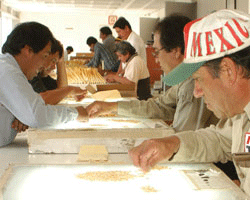
Lab workers at a seed bank in Mexico, sorting through seeds and selecting high-protein corn kernels for preservation in cold storage units. (Photo: Cutberto Garcia Ramos/USAID)
BASCOMB: The barren Arctic Circle will soon become one of the most biologically diverse areas in the world- for seeds that is.
Norway plans to build a seed bank on remote Spitsbergen Island. Just 600 miles from the North Pole, it is an ideal location for what will be the largest seed repository in the world. The island’s permafrost condition will keep the seeds dry and frozen no matter what happens to the rest of the world.

Lab workers at a seed bank in Mexico, sorting through seeds and selecting high-protein corn kernels for preservation in cold storage units. (Photo: Cutberto Garcia Ramos/USAID)
The Norwegian facility will accommodate 2 million seeds; mostly food producing plants, making it the largest of the world’s 1300 seed banks.
The 3 million dollar facility will act as a sort of seed savings and loan. Countries will be able to deposit and withdraw seeds as needed. Norway will own and operate the seed bank. However, they don’t seem too concerned about a stick up. According to management, the bank won’t have any security guards, other than an occasional polar bear.
That’s this week’s note on emerging science. I’m Bobby Bascomb
CURWOOD: And you’re listening to Living on Earth.
ANNOUNCER: Support for N-P-R comes from N-P-R stations, and: Kashi, whose “Day of Change” tour features yoga lessons, natural food cooking demos, and Kashi cereals, crackers and granola bars. Details at Kashi dot com; The Kresge Foundation, investing in nonprofits to help them catalyze growth, connect to stakeholders, and challenge greater support. On the web at Kresge dot org; and, The Kellogg Foundation, helping people help themselves by investing in individuals, their families, and their communities. On the web at w-k-k-f dot org. This is N-P-R -- National Public Radio.
[MUSIC: Roots Tonic “Road To Axum” from ‘Meets Bill Laswell’ (ROIR - 2006)]
CURWOOD: It’s Living on Earth. I’m Steve Curwood and coming up: the return of the blue heron to one small farm in Michigan. But first:
[LETTERS THEME]
Listener Letters
CURWOOD: Time now to hear from you, our listeners. Response to our hour-long show special investigating the past, present, and future of storm protection along the Gulf Coast of Louisiana was enthusiastic.
James Alls of Seattle writes “I just wanted to thank you for your special on Katrina/New Orleans levees. It was really first rate - tons of information - presented in a compelling way. I haven't heard or seen any coverage as good or as in depth as what I heard last night. You should win an award for that one. Keep up the good work!”
Our recent report on ways to keep cool this summer while saving energy did not tighten the efficiency belt nearly enough for some listeners. Take Charles Ward of Billings, Montana. He found our tip to use ceiling fans in combination with a/c units to let you set the a/c temperature higher – say, 72 to 75 degrees – a feeble improvement.
“I just about blew a compressor seal,” he writes. “Our household has been air conditioning down to 80 degrees for the last 27 years that I can recall, including 19 years in Las Vegas.” Mr. Ward adds: “Conserving resources and minimizing a person's ‘environmental footprint’ is not a big thing, it is a lot of little things. And it takes a lot more than raising the air-conditioned temperature from 68°F to 72°F.”
We recently aired a story about a group of residents in a poor section of San Francisco who, after decades of protest, persuaded a major utility to close a power plant in their backyard. But some listeners are still waiting for a happy ending.
Linda Clark of Provo, Utah, says the closure merely shifts the burden of energy generation to another neighborhood.
“You said the electricity is now coming through a transmission line. Where is the plant that is producing the electricity?” she writes. “Let's get beyond shifting pollution to continue using electricity.”
Your comments on our program are always welcome. Call our listener line anytime at 800-218-9988. That's 800-218-99-88. Or write to 20 Holland Street, Somerville, Massachusetts, 02144. Our e-mail address is comments at loe dot org. Once again, comments at loe dot org. And visit our web page at Living on Earth dot org. That's Living on Earth dot org, where you can hear us anytime.
[SOUND OF PIG GRUNTING]
The Good Good Pig
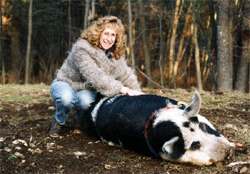
Sy Montgomery with Chris as a young adult resting on the Pig Plateau and enjoying a belly rub. (Photo: Ian Redmund)
CURWOOD: There’s nothing quite like the sound of a happy pig. This recording was taken several years ago atop the Pig Plateau, a wooded clearing in southern New Hampshire where a certain pig by the name of Christopher Hogwood would hold court, feasting on all manner of delicacies and slops. It was a charmed life, to say the least.
Christopher has since gone to hog heaven. And his owner, Living on Earth commentator Sy Montgomery, has written a memoir of all his misadventures. She joins me now with her new book, “The Good Good Pig: The Extraordinary Life of Christopher Hogwood.” And what a life it was! But Sy, maybe you should start from the beginning and tell us all, who exactly was Christopher Hogwood?
MONTGOMERY: Well Christopher Hogwood still actually is a famous conductor after whom we named a runty spotted pig who we adopted when he was so little he fit in a shoebox. He was a runt half the size of all the other runts at this piggery, in the year 1990. It was a very bad year for this poor little pig, because it’s hard enough being a runt, but being a runt half the size of the other runts he really had almost no chance of surviving. And he had every kind of disease possible. It was like George Burns on “The Simpsons,” you know?
Anyway, this pig was so sick and so runty that the people who own the piggery, who are friends of my husband and I, when I was in Virginia caring for my sick father, who was dying of cancer, they called my husband and said ‘How’d you like having a runt pig move in with you?’ And Howard said ‘normally I wouldn’t even tell her that you called, but her father’s dying, it’s a very hard time for her, and I think she’d really be cheered up by a sickly little pig.’ And so that’s how he came home to us.

Sy Montgomery with Chris as a young adult resting on the Pig Plateau and enjoying a belly rub. (Photo: Ian Redmund)
MONTGOMERY: Yes, and I’ve got to show you the very best part of it. If you take the paper cover off you’ll notice in the lower right-hand corner is a snout print embossed onto the cover. And I swear that’s exactly what Christopher would have done. Because he left his snout print on almost everything.
CURWOOD: Now this snout print, as you call it, is about the size of a quarter. Christopher Hogwood was on the, shall I say, large size.
MONTGOMERY: Yes. After he came home in a shoe box he grew to an enormous size nobody expected. He eventually got to be 750 pounds. And he lived to the very ripe old age of 14, and most pigs live to be six months. Of course, that’s because they quickly turn into bacon or salami or something like that. But because I’m a vegetarian and my husband is Jewish, that was not going to be his fate.
CURWOOD: (Laughs) A Kosher pig.
MONTGOMERY: Yes, he was.
CURWOOD: And if he got to 750 pounds, did you have to put him on a diet?
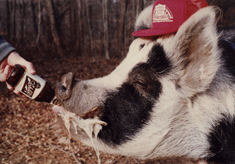
What is beer but liquid grain? Christopher enjoys a Schlitz. (Photo: Sy Montgomery)
And this was dreadful, because he was getting food from all over the place. People used to save their slops in the freezer for him and drive it in from other parts of the country. Some people actually mailed him slop. And we used to pick up these wonderful gourmet slops from Fiddlehead’s Café. We would lift the lid of the slops and out would waft the scent of balsamic vinegar and lovely delicate marinades and imported olives…
CURWOOD: Oh my gosh, this pig was eating out every night!
MONTGOMERY: Yes he was. And when we would go to some event in town, you know, a wedding or a reception or something, it was usually catered by Fiddlehead’s, and we’d find that we were eating the same stuff the pig was. But the presentation, of course, was different.
CURWOOD: (Laughs) Now, in some ways Christopher was something of an experiment, wasn’t he?
MONTGOMERY: Well we were really pushing the boundaries of porcine knowledge. No one really knew how long pigs lived. And we certainly didn’t know how big he’d get. We thought he might stay small. We were told by the folks who owned the piggery that there was a good chance that he would stay small, but the miracle of a swine warmer combined with Schlitz beer, which was one of his favorite things to drink, just – he grew very quickly. And so did his circle of friends.
CURWOOD: Along the lines of an experiment, so just how did your pig behave, you know, a little bit tight with all this beer?
MONTGOMERY: Ah! Well, we never got him drunk. I mean, he was just so big you couldn’t give him enough. He just loved the taste. But then he loved the taste of many things. And he had good taste in music, too, Steve. Pigs actually have quite a refined sense of many of the great fine things in life. They really can be quite sensitive, quite delicate. They’re very emotional creatures, and very kind at heart. They have a great sense of humor, Chris certainly did, and he was a sensitive soul.
CURWOOD: And a smart soul at that.
MONTGOMERY: Yes. Pigs are incredibly smart. Very few people realize that. But they’re so smart that in past centuries people who couldn’t afford hunting dogs used hunting pigs, and they would act like pointers. Quite a number of researchers have tested pigs’ intelligence, and they generally come out smarter than dogs. But my husband and I think that they actually – at least Chris did – come out smarter than us, because he got to have two college-educated people working full time for him for free.
CURWOOD: (Laughs) Eating the best food in town!
MONTGOMERY: That’s right.
CURWOOD: Now of course your book is not just about your relationship with Christopher Hogwood, your pig, but it’s about your life and your relationships and what’s going on in your family, particularly with your mom and dad. How did this pig, Christopher, influence those relationships?
MONTGOMERY: Well, when Chris came into my life my father was dying, my family was pretty much in shatters. I was an only child, and my parents had disowned me because they didn’t like who I married. And I married the greatest guy, but he was Jewish, and my mother was raised Methodist and she didn’t like that at all. So this book is really a book about family. I built another family when my family disowned me. And it was a multi-species household and it included people who weren’t genetically related to me, lots of kids who weren’t genetically related to me.
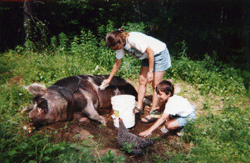
Antioch biology professor Beth Kaplan and her daughter Stella at Pig Spa. (Photo: Sy Montgomery)
MONTGOMERY: (Laughs) Well, first of all he was like our ambassador of the barnyard. I don’t know. I mean, I’m really kind of a shy person. Chris introduced me to my neighborhood. How? By busting out and running down the street and getting rescued by people who I hardly knew. We’d only been living there for a few years by the time Christopher came into our lives. But boy, I’ll tell ya, there’s nothing that’s going to get you to know your neighbors faster than a black and white spotted pig rooting up their lawn. So he introduced me to a lot of people in that way.
He also introduced me to children. When I was growing up, as I was a child I didn’t have friends who were children. I didn’t get along with other children for various reasons. But once I got Chris I had more friends who were children than I had in my entire childhood.
CURWOOD: What’s your favorite story about Christopher Hogwood?
MONTGOMERY: Oh, wow. Well, I just loved the performance art that he did of eating. And I loved how much he meant to people. And when he finally died, I’d never seen such an outpouring from people. And remember, he outlived my mother and my father, so I had been to funerals of people that I loved and people were very generous and kind to us. But when the pig died, the house was so full of flowers we filled up every single vase and every single pickle jar. We got cards and letters and phone calls and emails. People brought food, just like they do when a person died.
And some stories about him I found out after he died, of why he meant so much to so many people. And that ‘why’ was all over the place. In some cases people just loved the idea of Yankee thrift, that you could bring your garbage and he would eat it. In some cases people just loved him when he was tiny and he was so adorable and then he was so huge, he was so much fun.
But in other cases people told me stories, really heart-wrenching stories, of how Chris kind of completed a sad story and made it better. Or how Chris kind of redeemed a pig that one person had once had who she loved very much but who got shot, essentially by mistake by the butcher. Another person told me the story of why his wife loved the pig so much. And it was because she had been an orphan with a terrible childhood, and Chris had been an orphan too. But his childhood had been a wonderful, charmed childhood, and she loved him to bits because it was like her story rewritten and come out right.
CURWOOD: Sy Montgomery is the author of “The Good, Good Pig: The Extraordinary Life of Christopher Hogwood.” Thanks so much, Sy.
MONTGOMERY: Thank you, Steve.
Related link:
The Good Good Pig website
[MUSIC - Glenn Miller & His Orchestra “The Booglie Wooglie Piggy” from ‘The Essential Glenn Miller’ (RCA - 2005)]
The Herons Return
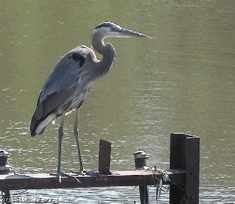
Great Blue Heron (Photo: Gene McDaniel, Raytown)
CURWOOD: “Wilderness” is not a term usually associated with the farmland and woodlots of the Midwest. Yet, commentator Tom Montgomery-Fate sees some wild hope in the return of Great Blue Herons to his farm in Michigan.
MONTGOMERY-FATE: Recently five pairs of great blue herons flapped back to our small farm in southwest Michigan to lay their eggs. Each spring they have returned in their gangly grace to patch and repair the great prickly bowls of sticks they first built four years ago. The now sturdy nests are about three feet across and sit 80 or 90 feet off the ground near the tops of two Sycamore trees. The trees drape over a small, polluted river which runs in to Lake Michigan.
Our land, like much of the central Midwest, has been harmed by agriculture, industry, and new development. Million dollar vacation homes have started popping up just down the road. The animals that thrive here are tough, raccoons and possums and coyotes, starlings and grackles and turkey vultures, species that quickly adapted to the ravaged habitat, to pesticides and herbicides, and the river that absorbed them.

Great Blue Heron (Photo: Gene McDaniel, Raytown)
If all these herons can find the frogs and fish they need to feed their fledglings, this is a good sign. Maybe the ongoing efforts to clean up the river and stave off soil erosion are actually helping.
This morning as I tramp through the woods I can hear the herons low grumbling when I’m still a quarter mile away—auditory bread crumbs leading me through the wild rose brambles and deadfalls. Their rough, low voices seem to tease me with a question: “What, What, What, What are you doing?”
“I’m watching,” I say aloud to myself, “just watching.” I lay flat on my back underneath the old sycamore with my binoculars aimed at the nests. One bird gets anxious, peers at me with a haunting yellow-ringed eye, and makes his decision. He stumbles around in the sticks, unfolds that great prehistoric S of a body and tumbles into the air with an awkward beauty that seems to fit these woods, this recovering bit of land in the non-wilds of the Midwest.
CURWOOD: Tom Montgomery-Fate teaches writing at College of DuPage in Glen Ellyn, Illinois, and is the author of a new memoir, “Steady and Trembling.”
[MUSIC: James Yorkston & The Athletes “Heron” from ‘Just Beyond The River’ (Domino – 2004)]
CURWOOD: We leave you this week at the receiving end of a fresh catch.
[SOUNDS OF FISH MARKET]
CURWOOD: At the Pike Street Market in Seattle, fishmongers hurl everything from king crab to halibut to one another before packaging it up for customers. And they’re none too quiet about giving a heads up.
[EARTH EAR - “Pike’s Place Fish Mongers” recorded by Ashley Ahearn in Seattle, WA. (May - 2006)]
CURWOOD: Now that’s a hefty halibut.
Living on Earth is produced by the World Media Foundation. Our crew includes Chris Ballman, Eileen Bolinsky, Jennifer Chu, and Ingrid Lobet - with help from Christopher Bolick, Kelley Cronin, and James Curwood. Bobby Bascomb is our intern, and we wish good luck to departing intern Emily Taylor. Our technical director is Dennis Foley. Alison Lirish Dean composed our themes. You can find us at LOE dot org. I’m Steve Curwood. Thanks for listening. Look out for that flying fish!
ANNOUNCER: Funding for Living on Earth comes from the National Science Foundation, supporting coverage of emerging science; Kashi, whose "Day of Change" tour features yoga lessons, natural food cooking demos, and an array of Kashi products. Details at Kashi dot com. Stonyfield Farm. Organic yogurt, smoothies and milk. Ten percent of profits are donated to efforts that help protect and restore the earth. Details at Stonyfield dot com. Support also comes from NPR member stations, the Ford Foundation, the Oak Foundation, and the Saunders Hotel Group of Boston's Lennox and Copley Square Hotels. Serving you and the environment while helping preserve the past and protect the future, 800-225-7676.
ANNOUNCER2: This is NPR, National Public Radio.
Living on Earth wants to hear from you!
Living on Earth
62 Calef Highway, Suite 212
Lee, NH 03861
Telephone: 617-287-4121
E-mail: comments@loe.org
Newsletter [Click here]
Donate to Living on Earth!
Living on Earth is an independent media program and relies entirely on contributions from listeners and institutions supporting public service. Please donate now to preserve an independent environmental voice.
NewsletterLiving on Earth offers a weekly delivery of the show's rundown to your mailbox. Sign up for our newsletter today!
 Sailors For The Sea: Be the change you want to sea.
Sailors For The Sea: Be the change you want to sea.
 The Grantham Foundation for the Protection of the Environment: Committed to protecting and improving the health of the global environment.
The Grantham Foundation for the Protection of the Environment: Committed to protecting and improving the health of the global environment.
 Contribute to Living on Earth and receive, as our gift to you, an archival print of one of Mark Seth Lender's extraordinary wildlife photographs. Follow the link to see Mark's current collection of photographs.
Contribute to Living on Earth and receive, as our gift to you, an archival print of one of Mark Seth Lender's extraordinary wildlife photographs. Follow the link to see Mark's current collection of photographs.
 Buy a signed copy of Mark Seth Lender's book Smeagull the Seagull & support Living on Earth
Buy a signed copy of Mark Seth Lender's book Smeagull the Seagull & support Living on Earth

